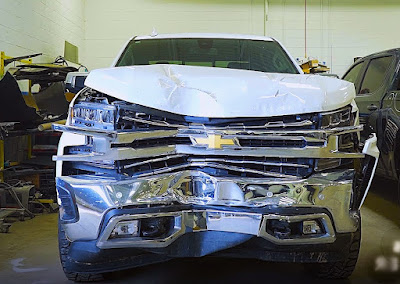Narrator: Car accidents are incredibly common. In 2017, there were almost 6.5 million car accidents in the United States alone. Collision centers use a variety of techniques to realign a vehicle's tires, restore damaged areas, and correct paintwork. JOAN: Here at the Hendrick Collision Center, we can fix anything from a small dent to a major overhaul that requires a structural overhaul. Some of the typical tools we use are Flatline, Frame Machine and Bondo. If your car is on a frame machine, it most likely has some type of structural damage.
When you're ready to install a car on the chassis machine, obviously drive it on the machine and make sure the car is square. The second part is that it will go to the computer to see where the fasteners on the car need to go. We have access to Alldata, a computer system that collects all the information from the manufacturer so that we can correctly repair the vehicles. Go ahead and start building the car on the clamps. Then you go to the measurement system, and the measurement system will tell you where the damage is.
How to repair these wrecked cars and put them back again
We have to digitally measure the chassis to make sure all the components are where they are needed, in millimeters. And then you have to reverse the damage. When you work, you have to pay attention to your surroundings. Obviously, make sure you are in a safe place and that everyone around you is safe. You have to be very careful in noticing the damage and how to remove it. The measurement system is connected to the computer, you can see the numbers moving as you drag, you want those numbers to be as close to zero as possible.
A frame machine can be very intimidating. Often the claws come out and fly, so you have to overcome this fear. Not all scrapers require such a large machine. For smaller, more delicate scratches, we use the tray. The first step is to make sure you acknowledge the damage that has been done to you. That's why we've implemented a special light so you can see any damage on the board. Be sure to sand the area you are preparing to shoot. Make sure you have a good ground, a solid ground, before you start putting the keys on the metal. Not all curvatures are straight lines.
Sometimes the stripes have a curve. Immediately after soldering the switches, the drawing process begins. You choose the correct bridge to use. When the bridge is turned, it has a handle with threads. And when you turn the cable, the neck shortens and joins the bridge and the stem. The rod will remove the dent. If you have a deeper hit, you will have to throw more.
If you have a bump that isn't deep enough, you'll need to turn the handle a little lower. Then you have to click on the gear crowns. Every time you have a lump, create crowns. The bump doesn't necessarily come out.
Sometimes you need to reassess after shooting, and you probably need to shoot from a different spot to get as close to the bump as possible from your original position. After using the flat roller, we still need to smooth out the bump, and this is where the Bondo process begins. Bondo can be a fast drying sandable filler that we use to return car bodywork as close to its original shape as possible.
Once you've mixed up the Bondo in your mixer, we have plastic dispensers, and that's what you use to apply the dent. You need to make sure that you apply it to the right places and that you don't apply it too often in places where you don't need it. You need to make sure you are very flexible with this and keep the vehicle setup correct. Once you have applied the Bondo and sanded it down and are satisfied with how the dent feels and is visually correct, at this point you will take the car to the paint shop to have it painted.
One of the first steps in painting is to make sure all contaminants are removed from the panel. The part that has been completely replaced, or the part that has been repaired, is painted. Adjacent panels are also blended to ensure an exact color match. Therefore, the painting process is different for each vehicle, since each repair volume is different. But in a perfect world, from start to finish,


تعليقات: 0
إرسال تعليق